
Headsup: The deep expose with associated comments below was first posted by Finn MacCool on 12/20/13. Knox's failed calunnia trial in 2009, failed 1st appeal in 2011, and failed final appeal in 2013 had come and gone. Some 500 zombie misrepresentations had recently reappeared in Knox's English-only 2013 book. See main support documents here and also (vitally) this and this and this.
Category: Various hypotheses
Friday, January 19, 2018
Interrogation Hoax #21: Illustrating How Batshit Crazy The Knox Interrogation Hoax Has Become
Posted by Our Main Posters
Knox again making things up, despite vast evidence and her defense team to contrary
1. From Impeccable Police Process…
Click here for the overview of our huge Interrogation Hoax expose.
We are coming full circle now, with new translations showing what happened at the very start, from the day Meredith’s body was found, to the day of RS’s and AK’s arrests.
In those days Knox and Sollecito provided information about possible perpetrators in four relatively brief sessions with investigators in the central police station, and they signed the written records on every page.
It is pretty obvious from those signed depositions why no court believed Knox was forced to frame an innocent man.
Even Knox’s own defense team did not believe the hoax (yes she actually had one, though hoaxers leave this awkward fact aside). Though it took us some time to translate it all, some of that stark evidence against Knox has been available in English for years.
And yet it could be quicker to list here who among the Knox apologists HASN’T put this hoax on steroids than who has.
2. To Interrogation Hoax On Steroids
This is from a hyped keynote presentation to a New York conference of senior government justice officials from all over the world. It mentioned no original sources as proof and was not peer-reviewed. No attempt has ever been made to set the record right. The 37 untrue statements are rebutted in Part 3 below.
Meredith Kercher was found raped [untrue] and murdered in Perugia, Italy. Almost immediately [untrue] police suspected 20-year-old Amanda Knox [untrue], an American student and one of Kercher’s roommates””the only one who stayed in Perugia after the murder [untrue]. Knox had no history of crime [untrue] or violence and no motive [untrue].
But something about her demeanor [untrue] such as an apparent lack of affect [untrue], an outburst of sobbing [untrue], or her girlish and immature behavior [untrue] led police to believe [untrue] she was involved and lying, when she claimed she was with Raffaele Sollecito, her new Italian boyfriend, that night [untrue].
Armed with a prejudgment of Knox’s guilt [untrue] several police officials interrogated [untrue] the girl on and off for four days [untrue]. Her final interrogation started on November 5 at 10 p.m. [untrue] and lasted until November 6 at 6 a.m [untrue] during which time she was alone, without an attorney, tag-teamed by a dozen police [untrue] and did not break for food [untrue] or sleep [untrue].
In many ways, Knox was a vulnerable suspect””young, far from home, without family, and forced to speak in a language [untrue] in which she was not fluent. Knox says she was repeatedly threatened [untrue] and called a liar [untrue]. She was told [untrue], falsely [untrue], that Sollecito, her boyfriend, disavowed her alibi and that physical evidence placed her at the scene [untrue].
Despite a law that mandates the recording of interrogations, police and prosecutors maintain that these sessions were not recorded [untrue].
Police had failed to provide Knox with an attorney [untrue] or record the interrogations [untrue] so all the confessions [untrue] attributed to her were ruled inadmissible in court [untrue].
Still, the damage was done [untrue]. The confession [untrue] set into motion a hypothesis-confirming investigation [untrue], prosecution, and conviction”¦.
It is now clear that the proverbial mountain of discredited [untrue] evidence used to convict Amanda Knox and Raffaele Sollecito was nothing but a house of cards [untrue] built upon a false confession [untrue].
3. And Pesky Hard Facts
Neither Knox’s own lawyers nor any court ever believed Knox’s fluctuating versions of what happened on 5-6 November 2007 to make her frame Patrick for murder and maintain that for 2 weeks.
Only a guilty person would let such claims stand. All courts saw that and so Knox is a convicted felon for life. She served three years for the malicious accusation, and she still owes the victim $100,000.
Below, how to destroy the hoax in 12 points. See further our extremely detailed 20-part series on Knox’s interrogation hoax (via the link in our right column) with numerous translations as proof.
1. Police provably kept open minds, and did not immediately suspect Knox though her odd behaviors were hard to miss, or treat her differently than others with possible useful facts.
2. She was not the only one with possible useful facts told to stay in Perugia for several days; others were told they might be needed again; no others complained.
3. There is no documented investigator prejudgement of guilt, even at her fourth and final quite short session on 5 Nov when the subject was provably once again listing more visitors to the house.
4. She was never tag-teamed by a dozen police, and she signed every page of all four session reports which named the mere several officers who were there.
5. There was no 50 or more hours of sessions. No session lasted from 10:00 pm to 6:00 am. All four of her sessions over 4 days combined may not have exceeded that length of time.
6. The fourth and final session on 5-6 Nov was unplanned, and when she turned up late on 5 Nov and was told to go get some sleep, she insisted she wanted to remain.
7. All four sessions were recorded and she signed. She was never threatened or called a liar; her conniption when shown a text message on 5-6 Nov happened spontaneously and very fast.
8. On 5-6 Nov 2007 Sollecito also u-turned - and blamed Knox! No tag-team there. Knox never confessed; she made a false charge of murder against someone else, allowed to stand for several weeks.
9. She did not simply claim she was with Sollecito that night; under no pressure she repeated several times in writing that she went out and all courts allowed that. Sollecito said she did too.
10. After she broke she was told several times she should not talk further without an attorney. No questions were asked of her after that but she pressed on.
11. She had a translator at all four sessions, though she herself chose to speak in Italian now and then. She made and handed over notes in Italian.
12. At trial she confirmed she was provided with refreshments and helped to get some sleep. She was never refused bathroom breaks and confirmed she was not hit.
4. In Conclusion
This hoax is a money-tree for Knox. A blood-money tree. Act the real victim, shake the tree, and tens of thousands fall out. Knox is to blame, but far from the only one. Most of the hoaxers are trying to shake their own money-trees too. Knox’s speaker agency and her PR and lawyers and publishers all want a big payday. Huge sums are at stake.
Can the hoax survive? Probably not for long. It needed a 100% rebuttal which finally we have achieved now. And it needs Knox’s confidence and her credibility. Even one disbelieving voice from the audience could show the world that the empress has no clothes.
Saturday, December 09, 2017
Exoneration Hoax: Murder Apologists Should READ The Supreme Court’s Final Words
Posted by The Machine

Emory Law Dean Schapiro; Martha Grace Duncan; Harvard Law Dean Manning
1. Overview Of This Post
This flows from our first post ten days ago.
Martha Grace Duncan credits many dozens for their research help. Really? For precisely what?
This is more about the research that Martha Grace Duncan and the huge group she thanks (see Part 4 below) should have done. We will see here how she makes false claims that even a mere hour or two of checking if the courts actually said what she claimed would have stopped those claims dead in their tracks.
Did neither Duncan nor any of those hapless dozens now associated with her fraud think to do that? Below, with quotes, I will show how it is done.
2. Misrepresentation Of Supreme Court
It is blatantly apparent from reading Martha Grace Duncan’s academic paper bizarrely titled “WHAT NOT TO DO WHEN YOUR ROOMMATE IS MURDERED IN ITALY: AMANDA KNOX, HER “STRANGE” BEHAVIOR, AND THE ITALIAN LEGAL SYSTEM” that she hasn’t actually read Judge Marasca’s final Supreme Court report.
She is ignorant of what that court actually said, and so she thoroughly misrepresents it.
Remember: (1) An acquittal under paragraph 1 of article 530 is a definitive acquittal or exoneration, the much stronger outcome. (2) An acquitted under paragraph 2 of article 530 is an insufficient evidence acquittal or dropping of charges for now.
Also remember: Knox received TWO convictions: (1) for murder and (2) for calunnia. Duncan falsely claims in her academic paper that Amanda Knox has been “fully exonorated by Italy’s highest court” implying both. Knox was not exonerated for either conviction in fact.
If Martha Grace Duncan had read the final Supreme Court report, she would have known that Amanda Knox and Raffaele Sollecito were merely acquitted for murder for now under paragraph 2.
(That is appealable, as is overuling of the Nencini court and dabbling in the evidence, as both are against the code.)
Martha Grace Duncan further highlights her ignorance with regard to the contents of Marasca’s Supreme Court report by falsely claiming that the Supreme Court dropped all charges against Amanda Knox and Raffaele Sollecito.
“March 29, 2015: The Supreme Court of Cassation overturns the murder convictions of Amanda and Raffaele and drops all charges against them.”
The Supreme Court actually reconfirmed Amanda Knox’s conviction for calunnia. She served three years in prison for repeatedly accusing Diya Lumumba of murder despite the fact she knew he was innocent.
“It is restated the inflicted sentence against the appellant Amanda Marie Knox, for the crime of slander at three years of prison.”
Judge Marasca pointed out in his report that Amanda Knox’s conviction for calunnia cannot be overturned.
“On the other hand, in the slanderous declaration against Lumumba, which earned her a conviction, the status of which is now protected as a final judgement”.
There is a common misconception amongst Amanda Knox’s supporters that the European Court of Human Rights (ECHR) might overturn Knox’s conviction for calunnia.
However, she is believed not even to have asked for that. And the ECHR cannot quash or reverse verdicts anyway, it can only recommend. In other words, Amanda Knox will remain a convicted criminal, a felon, for the rest of her life. That cannot be wound back.
Appeal Judge Nencini pointed out in his report that Amanda Knox didn’t retract her false and malicious allegation against Diya Lumumba the whole time he was in prison, and the motive for her allegation was to deflect attention away from herself and Sollecito and avoid retaliatory action from Rudy Guede.
“Amanda Marie Knox maintained her false and malicious story for many days, consigning Patrick Lumumba to a prolonged detention. She did not do this casually or naively. In fact, if the young woman’s version of events is to be relied upon, that is to say, if the allegations were a hastily prepared way to remove herself from the psychological and physical pressure used against her that night by the police and the prosecuting magistrate, then over the course of the following days there would have been a change of heart. This would inevitably have led her to tell the truth, that Patrick Lumumba was completely unconnected to the murder. But this did not happen.
“And so it is reasonable to take the view that, once she had taken the decision to divert the attention of the investigators from herself and Raffaele Sollecito, Amanda Marie Knox became fully aware that she could not go back and admit calunnia. A show of remorse would have exposed her to further and more intense questioning from the prosecuting magistrate. Once again, she would bring upon herself the aura of suspicion that she was involved in the murder.
Indeed, if Amanda Marie Knox had admitted in the days following to having accused an innocent man, she would inevitably have exposed herself to more and more pressing questions from the investigators. She had no intention of answering these, because she had no intention of implicating Rudy Hermann Guede in the murder.
“By accusing Patrick Lumumba, who she knew was completely uninvolved, because he had not taken part in the events on the night Meredith was attacked and killed, she would not be exposed to any retaliatory action by him. He had nothing to report against her. In contrast, Rudy Hermann Guede was not to be implicated in the events of that night because he, unlike Patrick Lumumba, was in Via della Pergola, and had participated [100] in the murder. So, he would be likely to retaliate by reporting facts implicating the present defendant in the murder of Meredith Kercher.
“In essence, the Court considers that the only reasonable motive for calunnia against Patrick Lumumba was to deflect suspicion of murder away from herself and from Raffaele Sollecito by blaming someone who she knew was not involved, and was therefore unable to make any accusations in retaliation. Once the accusatory statements were made, there was no going back. Too many explanations would have had to be given to those investigating the calunnia; explanations that the young woman had no interest in giving.”
The Marasca/Bruno court took no issue with that. Judge Marasca also believed Amanda Knox wanted to avoid retaliatory action from Rudy Guede and stated it was a circumstantial element against her.
“However, the said calunnia is another circumstantial element against the appellant, insofar as it can be considered a strategy in order to cover up for Mr. Guede, whom she had an interest to protect because of fear of retaliatory accusations against her.”
Apart from these two significant factual errors concerning the Supreme Court’s rulings in her academic paper, it’s clear that Martha Grace Duncan is labouring under the misapprehension that Amanda Knox was “fully exonerated” by the Supreme Court because there is some exculpatory evidence that provides definititve proof that Amanda Knox is innocent. However, she never explains what this exculpatory evidence is.
If Martha Grace Duncan had taken the time to read Marasca’s report, she would have known that the Supreme Court didn’t fully exonerate Amanda Knox at all. On the contrary, it actually implicated her in Meredith’s murder.
It ascertained the following: (1) there were multiple attackers (2) it’s a proven fact that Amanda Knox was at the cottage when Meredith Kercher was killed (3) she washed Meredith’s blood off in the small bathroom (4) she lied to the police (5) she falsely accused Diya Lumumba of murder to cover for Rudy Guede in order to avoid retaliatory action and (6) the break-in at the cottage was staged.
I’ll substantiate each and every one of the claims above with quotations from Judge Marasca’s report to show Martha Grace Duncan how it is done and to give her the full picture of what’s in the report rather than the partial one that has been given to her presumably by Amanda Knox and her supporters.
1. There Were Multiple Attackers On The Night
“The [court’s] assessment of it, in accord with other trial findings which are valuable to confirm its reliability is equally correct. We refer to multiple elements linked to the overall reconstructions of events, which rule out Guede could have acted alone.
Firstly, testifying in this direction are the two main wounds observed on the victim’s neck, on each side, with a diversified path and features, attributable most likely (even if the data is contested by the defense) to two different cutting weapons. And also, the lack of signs of resistance by the young woman, since no traces of the assailant were found under her nails, and there is no evidence of any desperate attempt to oppose the aggressor, the bruises on her upper limbs and those on mandibular area and lips (likely the result of forcible hand action of constraint meant to keep the victim’s mouth shut) found during the cadaver examination, and above all, the appalling modalities of the murder which were not pointed out in the appealed ruling.
“And in fact, the same ruling (p323 and 325) reports of abundant blood found on the right of the wardrobe located in Kercher’s room, about 50cm above the floor. Such occurrence, given the location and direction of the drops, could probably lead to the conclusion the young woman had her throat literally “slashed” likely while she was kneeling , while her head was being forcibly held tilted towards the floor, at a close distance from the wardrobe, when she was hit by multiple stab wounds at her neck, one of which - the one inflicted on the left side of the neck - caused her death, due to asphyxia following the massive bleeding, which also filled the breathing ways preventing breathing activity, a situation aggravated by the rupture of the hyoid bone - this also linkable to blade action - with consequent dyspnoea” (p.48).
“Such a mechanical action is hardly attributable to the conduct of one person alone.” (p.49)
2. Amanda Knox was there when Meredith was killed
“Given this, we now note, with respect to Amanda Knox, that her presence inside the house, the location of the murder, is a proven fact in the trial, in accord with her own admissions, also contained in the memoriale with her own signature, in the part where she tells that, as she was in the kitchen, while the young English woman had retired in the room of same Ms Kercher, together with another person for a sexual intercourse, she heard a harrowing scream, so piercing and unbearable that she let herself down squatting on the floor, covering her ears tight with her hands in order not to hear more of it. About this, the judgement of reliability expressed by the lower [a quo] judge [Nencini] with reference to this part of the suspect’s narrative, [and] about the plausible implication from the fact herself was the first person mentioning for the first time [46] a possible sexual motive for the murder, at the time when the detective still did not have the the cadaver examination, nor the autopsy result, nor the witnesses’ information, which collected only subsequently, about the victim’s terrible scream and about the time when it was heard (Nara Capezalli, Antonella Monocchia and others), is certainly to be subscribed to. We make reference in particular to those declarations that the current appellant [Knox] on 11.6.2007 (p.96) inside the State Police headquarters. On the other hand, in the slanderous declaration against Lumumba, which earned her a conviction, the status of which is now protected as a final judgement [giudicato] [they] had a premise in the narrative, that is the presence of the young American woman, inside the house in via della Pergola, a circumstance which nobody at that time - except obviously the other people present in the house - could have known (quote p.96).
“According to the slanderous statements of Ms. Knox, she had returned home in the company of Lumumba, whom she had met by chance in Piazza Grimana, and when Ms. Kercher arrived in the house, Knox’s companion, directed sexual attentions toward the English woman, then he went together with her to he room from which the harrowing scream came. So, it was Lumumba who killed Meredith and she could affirm this since she was on the scene of the crime herself, albeit in another room. (p.97)
3. Amanda Knox washed Meredith’s blood off in bathroom
“Another element against her [Amanda Knox] is the mixed traces, her and the victim’s one, in the ‘small bathroom’, an eloquent proof that anyway she had come into contact with the blood of the latter, which she tried to wash away from herself (it was, it seems, diluted blood, while the biological traces belonging to her would be the consequence of epithelial rubbing).
“The fact is very suspicious, but it’s not decisive, besides the known considerations about the sure nature and attribution of the traces in question.”
4. Cassation confirms Amanda Knox lied to the police
“Elements of strong suspicion are also in the inconsistencies and lies which the suspect woman [Amanda Knox] committed over the statements she released on various occasions, especially in the places where her narrative was contradicted by the telephone records which show different incoming SMS messages”.
5. Knox accused Lumumba of murder to avoid Guede’s retaliation
“However, the said calunnia is another circumstantial element against the appellant, insofar as it can be considered a strategy in order to cover up for Mr. Guede, whom she had an interest to protect because of fear of retaliatory accusations against her.”
6. The break-in at the cottage was staged
“And moreover, the staging of a theft in Romanelli’s room, which she is accused of , is also a relevant point within an incriminating picture, considering the elements of strong suspicion (location of glass shards - apparently resulting from the breaking of a glass window pane caused by the throwing of a rock from the outside - on top of the clothes and furniture) a staging, which can be linked to someone who as an author of the murder and flatmate [titolare] with a formal {“qualified”] connection to the dwelling - had an interest to steer suspicion away from himself/herself, while a third murderer in contrast would be motivated by a very different urge after the killing, that is to leave the dwelling as quickly as possible.”
3. Duncan’s Misrepresentation Of Supreme Court
Writing an academic paper on the Amanda Knox case without having read Judge Marasca’s Supreme Court report is akin to writing an academic paper on the assassination of JFK without having read the Warren Report and relying on Oliver Stone’s film and some books written by conspiracy nuts.
The fact Martha Grace Duncan hasn’t even read Marasca’s Supreme Court report, but has instead relied primarily on Amanda Knox and her PR and partisan supporters for her information is embarrassing, to say the least.
Amanda Knox admitted lying to the police in her Waiting to Be Heard. She was convicted of lying by all courts, including the Italian Supreme Court. Since when did the word of a convicted liar trump the official court reports?
Martha Grace Duncan is a professor of law, although you couldn’t tell that from reading her academic paper. Her mistakes e.g. getting basic facts wrong and not bothering to read Marasca’s Supreme Court report or any other official court reports for that matter are unforgivable.
An early version of this Article received the Judith Siegel Pearson Award for Nonfiction in 2014. I am grateful to the judges. Previous versions of this Article were presented at the Dipartimento di Giurisprudenza, Università degli Studi di Torino; the European University Institute, Fiesole, Italy; the Emory Law Faculty, the Emory Psychoanalytic Studies Program, and the Emory Workshop on Geographies of Violence. My thanks go to the participants. My thanks also go to Robert Ahdieh, Giulia Alagna, Cathy Allan, Flavia Brizio-Skov, Michele Caianiello, Elisabetta Grande, Joe Mackall, Stefano Maffei, Alice Margaria, Claudia Marzella, Gaetano Marzella, Colleen Murphy, David Partlett, Lucia Re, Bob Root, Elena Urso, and Liza Vertinsky. Deep appreciation goes to my research assistants: Stefania Alessi, Mary Brady, Andrew Bushek, Peter Critikos, Sarah Kelsey, Tess Liegois, Zishuang Liu, Mike McClain, Jon Morris, Kaylie Niemasik, Sarah Pittman, Faraz Qaisrani, Deborah Salvato, Shannon Shontz-Phillips, Anthony Tamburro, and Michelle Tanen.
Thursday, November 30, 2017
The Academic Fraud By Martha Grace Duncan Enabled By Emory & Harvard Law Schools
Posted by Our Main Posters

Emory Law Dean Schapiro; Martha Grace Duncan; Harvard Law Dean Manning
1. Yet Another Major Academic Fraud
Our main poster The Machine has spotted yet another academic fraud.
She is Martha Grace Duncan of Emory University, in Atlanta USA.
She joins a long line of other academic fraud we continue to expose. She follows and freely borrows from such other academic charlatans as Doug Bremner, Chris Halkidis, Greg Hampikian, Saul Kassin, Michael Krom, Michael Wiesner, Peter Gill, and Mark Waterbury.
She especially emulates the quack law-school psychologist Saul Kassin. He also could not explain the equal official focus on Sollecito by way of the madonna/whore complex which the PR shill Nina Burleigh also propagated hard.
Christine Corcos runs the blog where the Martha Duncan notice that the Machine spotted appears. She tells us in an email that the article will appear in a scholarly legal journal. Christine Corcos is not certain whether peer review has already happened or is still ahead but it is expected.
But Duncan’s flippant, xenophobic, callous, me-me-me paper is already widely published without peer review. By Harvard University Law School! Those who failed to vet it include Nasheen Kalkat, Alexa Meera Singh, and Brianne Power.
Duncan promotes the paper avidly and seems to have already duped thousands. She beats the drum about the paper on these lines.
Previous versions of this Article were presented at (1) the Dipartimento di Giurisprudenza, Università degli Studi di Torino; (3) the European University Institute, Fiesole, Italy; (3) the Emory Law Faculty, (4) the Emory Psychoanalytic Studies Program, and (5) the Emory Workshop on Geographies of Violence.
2. Duncan’s Simplistic, Self-Serving Thesis
Large parts of the paper are about Duncan herself. In the passages devoted to the case. Duncan seeks to make readers believe that Knox was demonized, charged and convicted.
Why? Because she was “free-spirited”. We get endless tortured examples. That’s it, apparently. Nothing else. There was no real case against Knox at all. Foolish prosecutors. Foolish judges. Foolish juries. Foolish Italy.
And the demonizer who amazingly swayed all of them? One of the prosecutors, Dr Mignini, an Italian and a Catholic (both groups Duncan tars as anti-women).
3. Duncan’s Appalling List Of Omissions
Duncan’s flippant, xenophobic, me-me-me paper with its dozens of false Knox PR talking points omits even more than she fraudulently includes.
1. Duncan ignores the victim, Meredith (mentioned only briefly and pretty callously).
2. Duncan ignores that Knox was not an exchange student, that she was perhaps the only American student who turned her back on available funding and any possibility of course credits.
3. Duncan ignores the bizarrely grubby, noisy, sharp-elbowed, tin-eared, self-absorbed behavior that was making Knox so unpopular in Perugia.
4. Duncan ignores Knox’s proven over-the-top drug use, extending back to Seattle and that Knox was stinking of cat-pee on the morning of the murder, a sign of cocaine use (and of no recent shower).
5. Duncan ignores the breaks Dr Mignini gave Knox. She ignores what he actually said. She ignores that he have her several breaks which her lawyers urgen her to take.
6. Duncan ignores Knox’s endless trail of incriminating behaviors.
7. Duncan ignores the co-defendant Sollecito (mentioned only once, because he doesnt fit the demonizing-of-Knox theory).
8. Duncan ignores the kind boss Knox maliciously framed, put in prison for two weeks, served three years for framing, and still owes $100,000 (Patrick).
9. Duncan ignores that two courts were provably corrupted and known to be so in Italy and that the mafias had a major role.
10. Duncan ignores that Knox’s so-called “interrogation” was a hoax, she was treated well, and she did not confess.
11. Duncan ignores or advances over 30 other hoaxes as listed in our right column.
12. Duncan ignores that the 30-plus judges who handled the case published extensive lists of evidence.
13. Duncan ignores that there were two unanimous pro-guilt juries (and one corrupted one).
14. Duncan ignores that Knox was NOT exonerated by the Supreme Court, bent though it was, and she was placed at the scene of the crime. .
15. Duncan ignores Knox’s promotion of the stalking of the victim’s family (a felony).
16. Duncan ignores that Italy’s murder and incarceration rates are 1/6 those of the US.
17. Duncan ignores the co-prosecutor Dr Manuela Comodi, never once mentioned, presumably because a very bright woman prosecutor doesnt fit the demonizing-of-Knox theory.
18. Duncan ignores the huge wave of court documents or trial transcripts which of course support none of her thesis.
More? Please see here.
Friday, February 26, 2016
Surprising Similarities Between Sammy The Bull Gravano And The Ex-Perps In Meredith’s Case
Posted by Chimera
Overview
This piece is about Salvatore (Sammy the Bull) Gravano, an admitted serial killer.
He had a career in the mafia, and was the underboss and hitman for the notorious mob boss John Gotti. Although his is a case about organized crime, there are many similarities between Gotti v Gravano, and Knox v Sollecito v Guede.
Some Gotti/Gravano history
John Gotti was a captain in the Gambino crime family (named after Carlo Gambino), based in New York, NY. A serious problem emerged for him when several members of his ‘‘crew’’ were indicted for drug dealing.
These indictments included his younger brother, Gene Gotti, and Angelo Ruggiero, a childhood friend. The policy within the crime family for many years had been ‘‘deal-and-die’‘.
The upper leadership of the mob had figured that drug dealing was too high profile a crime, and that the extra police attention was not worth it. True, this was extremely hypocritical, as the bosses collected their cut of all income, knowing that a large portion of those proceeds came directly from drugs.
The drug indictments suddenly meant that John Gotti was in danger.
Though not personally implicated, he thought he might also be killed on the assumption that he approved of the alleged dealing. He decided to strike first, to save his own neck by having then boss Paul Castellano ‘‘rubbed out’‘. Gotti solicited the help of Salvatore (Sammy the Bull) Gravano, who was known as a prolific killer.
Paul Castellano had inducted Gravano into the mob in 1978. However, Gravano had no qualms about killing his ‘‘friend’’ since Gotti offered him even more: a promotion to ‘‘capo’’ or to ‘‘captain’‘.
Gravano helped Gotti set up the hit for December 16, 1985. With Castellano (and driver Tommy Billoti who was at the time underboss) dead, the family was temporarily leaderless. Gotti got himself voted in, and took over the Gambino family.
Castellano wasn’t the only ‘‘friend’’ that Gravano murdered, or would later murder. Gravano murdered Robert di Bernardo—a business partner, Louie Molito—a childhood friend, and others. He then took over any assets that they had. Some ‘‘friend’‘.
For the next several years, Gotti deliberately put himself into the spotlight. He managed to win 3 criminal trials, and seemed untouchable. However, in 1990, his mouth got him into trouble, and the FBI recorded Gotti implicating himself and other Gambino associates on murder and other crimes.
Gotti also made many nasty insults towards Gravano, now his underboss.
Gotti, Gravano, and Frank LeCasio (then the 3rd in command) were arrested December 11, 1990. All were held without bail. When Gravano finally heard the tapes of what Gotti had been saying about him, he turned and became a ‘‘mob rat’‘. Gotti and LeCasio were convicted of murder, racketeering and other crimes, and received life without parole.
Gravano, however got a deal that would put Karla Homolka to shame: 5 years for 19 murders. True, he could have served 20 for racketeering, but the judge cut it far below that.
For the complete interview, please see the YouTube video at the top here. This was shot in the 1990’s and converted to digital, so the quality is not that great. Here are a few more for background. The third one, the movie ‘‘Gotti’’ is fairly accurate, though off on some points.
- More on Sammy Gravano.
- More on the Gambino Family.
- More on John Gotti.
Gambino family highlights
(1) Albert Anastasia (underboss to Vincent Magino) made his ‘‘friend’’ disappear. Anastasia then took over.
(2) Carlo Gambino (underboss to Albert Anastasia) had his ‘‘friend’’ shot in a barbershop. Gambino then took over.
(3) Carlo Gambino made sure the ‘‘best qualified person’’ took over when he had a heart attack. He hand picked his brother-in-law Paul Castellano to succeed him.
(4) Paul Castellano’s underboss, Neil Delacroce, died of cancer. Castellano hand picked his buddy, Tommy Bilotti, to become new underboss.
(5) John Gotti and Salvatore (Sammy) Gravano, had their ‘‘friend’’ Paul Castellano shot dead in public. Gotti took over.
(6) While in prison, John Gotti made sure the best qualified person succeeded him as boss. He hand picked his son, John Jr.
So…. murder and nepotism seem to be how the top spots get filled in the mafia.
Excerpts From the Video
2:55 (Gravano) You can relate me to a soldier in Vietnam who killed hundreds of people. I was a soldier of Cosa Nostra. I am a hitman.
No. You are just a slimeball who kills for money.
3:25 (Gravano) Here I am
3:30 (Sawyer) They have said that you are the single most important witness ever to testify against the mob.
3:36 (Gravano) I think I am.
3:39 (Sawyer) So there’s a word you use, for people who turn ...
3:42 (Gravano) Who cooperate. You trying to goat me into the word? Rat? Is that the word?
3:51 (Sawyer) That’s the word. So are you a rat?
3:53 Gravano) I look at it as ‘‘I was betrayed. I betrayed him.’‘
3:59 (Sawyer) Double crosser?
4:01 (Gravano) Loud sigh ... master double-crosser. John’s a double-crosser. I’m a master double-crosser. We played chess, and he lost.
Gravano had in the past sneered at the idea of people testifying. However, when it is his turn, he dismisses it as a game.
4:30 (Gravano) Power has a way, where you can believe for a while that you can walk on water. And I think this is what happened to him.
And people who can walk away from 19 murders? What are they thinking?
5:25 (Sawyer) Were you Gotti’s friend?
5:30 (Gravano) His pit bull. And his friend.
5:42 (Sawyer) What was the reason, the real reason you cooperated? Or was it just to save your skin?
5:48 (Gravano) I was just tired of the mob, and tired of fighting. It was a door out of the mob. You know I watched the David Karresch incident, and I would say to myself: ‘‘how could these people get so brainwashed? Are they crazy? Are they nuts?’’ And then I look at myself in the mirror and I say ‘‘brainwashed?’’ Here I am on orders, killing people left and right. And I’m calling them brainwashed.
6:18 (Sawyer) There was a book written about you that you said you had a characteristic of committing murder with the non-chalence of someone pulling open the tab on a can of beer. That was about all that it phased you, or about all it took.
6:30 (Gravano) As far as being a hitman goes, I was actually good at it.
6:36 (Sawyer) Because you were fast, and lethal?
6:39 (Gravano) And loyal. If I was on your case, I dropped everything.
6:45 (Sawyer) Look at this list. There are ... how many?
6:49 (Gravano) 19
6:51 (Sawyer) Serial killers don’t have 19.
6:53 (Gravano) We’re worse than they are.
Okay, which is it? You turned on Gotti because it was a chess game? Or you did it because you were tired of the mob and the games? It can’t be both.
7:00 (Gravano) We only kill ourselves. What are you worried about? The public seems to like what we do. Look at John Gotti. If I have 19, forget about what he has. When he wanted a hit, he wanted it done yesterday. He would sent me to supervise it, or to control it, make sure the job got done. And I obviously did. When you’re the boss, and you’re giving orders, you’re credited with all of it, even if you’re not on the street.
Gravano is pulling the ‘‘John was even worse’’ card here. And he seems somewhat proud of what he has done. Sicko.
17:55 (Gravano) I remember something that surprised me is that I had no remorse at all. None. I didn’t feel sorry for him in the least. I felt power. I felt like my adrenaline in my body was completely out of control.
18:09 (Sawyer) You were excited?
18:13 (Gravano) I guess it’s like an animal going after its prey.
18:35 (Gravano) Everything changed. .... At a club, oh, no Sammy, you don’t have to wait in line. You can come right in.
18:40 (Sawyer) You were a player?
18:45 (Gravano) I was out of the minor leagues. I was in the major leagues.
No comment needed.
Other parallels with our pair
- Gravano is of Italian-American descent.
- Knox is American.
- Sollecito is Italian.
- Gravano was paid $1.5 million for ‘‘his’’ book called Underboss.
- Knox was paid $3.8 million for ‘‘her’’ book called Waiting to be Heard.
- Sollecito was paid $950,000 for ‘‘his’’ book, called Honor Bound
- Gravano tried to ‘‘cash in’’ on his murders by admitting what he had done.
- Knox/Sollecito tried to ‘‘cash in’’ on Meredith’s murder
- ’‘Gravano’s’’ book was really written by Peter Maas.
- ’‘Knox’s’’ book was really written by Linda Kuhlman.
- ’‘Sollecito’s’’ book was really written by Andrew Gumbel.
- The families of Gravano’s victims are outraged he is cashing in on the notoriety of his crimes.
- The Kercher family is outraged AK/RS are cashing in on the notoriety of their crimes.
- Gravano got an interview from Diane Sawyer.
- Knox’s first (of many) interviews was with Diane Sawyer.
- Sollecito’s first (of several) interviews was with Katie Couric.
- Gambino boss John Gotti was referred to as ‘‘John Gotti’‘.
- Sammy Gravano was referred to as ‘‘John Gotti’s Hitman’‘.
- Amanda Knox is referred to as ‘‘Amanda Knox’‘
- Raffaele Sollecito is referred to as ‘‘Amanda Knox’s Italian Ex-Boyfriend’‘
- Gravano has no problems airing personal details about his ‘‘friend’’ John.
- Knox has no problems airing personal details about her ‘‘friend’’ Meredith.
- Gravano criticizes Gotti’s public lifestyle, then after his deal becomes a media whore.
- Knox claims she wants to live in peace, but becomes a media whore to sway public opinion, and sell ‘‘her’’ book.
- Sollecito claims he was just dragged into Knox’s case, but becomes a media whore for the same reasons as Knox.
- Gravano blames Gotti for destroying the Gambino family, even though he was the one who testified at trial.
- Knox seems to blame Meredith for her own death, even though she stuck the knife in (well, she had it coming).
- Gravano (at least he claims) to have rigged Gotti’s racketeering trial to ensure an acquittal (or at worst a hung jury)
- Knox’s and Sollecito’s case was rigged by Hellmann/Zanetti and Marsca/Bruno to ensure an acquittal.
- Gravano was psychologically evaluated before leaving prison, and the results were disturbing.
- Knox and Sollecito were psychologically evaluated in prison, and the results were disturbing.
- Gravano smeared other mob associates for getting involved with drug trafficking.
- Knox smeared others (especially in her book) for drug use.
- Gravano’s drug smears were hypocritical as he was later brought to justice for drug trafficking.
- Knox’s drug smears were hypocritical, as she was into drugs, and slept with a dealer (Federico Martini) for drugs.
- Gravano’s most depraved act (outside of murder), was marrying a woman whose brother he had killed (Nick Scibetta).
- Knox’s most depraved act (outside of murder), was continuing her sex-for-drugs deal even after Meredith’s death.
- Sollecito’s most depraved act (outside of murder), was his various bride shopping efforts to avoid extradition.
- Warning signs? Gravano murdered his business ‘‘friends’‘, so betraying Gotti was no real surprise.
- Warning signs? Knox staged a break in, wrote rape stories, and threw rocks at cars, so violence in her home was no real surprise.
- Warning signs? Sollecito had supposedly attacked a classmate with scissors, so stabbing someone was no real surprise.
- Collateral damage? Gravano was prepared to kill innocent bystanders during the December 16, 1985 hit on boss Paul Castellano.
- Collateral damage? Knox framed an innocent person (Lumumba), and tried to pin it all on accomplice Rudy Guede.
- Collateral damage? Sollecito helped to pin it all on Guede, and cost his sister Vanessa her career with the Carabinieri.
A Final Thought:
Knox liked the Beatles. Here is ‘‘Working Class Hero’’ by John Lennon.
.... There’s room at the top
They’re telling you still
.... But first you must learn how to
Smile as you kill
.... If you want to be like all
The folks on the ‘Hill
Tuesday, February 23, 2016
Why The Peaking Of Rage And Early Deaths Of Middle-Aged Lower-Prospects Whites In The US?
Posted by Peter Quennell
Recently a study was published showing that middle-aged less-successful whites in the US are dying off unusually fast.
Approximately this same group may be behind the “radical” candidatures for president of Bernie Sanders and Donald Trump. No question but that those supporters have a serious unmet need.
It may also be behind a lot of the rage we encounter on the web.
In the New York Times this “reference group theory” hypothesis by Andrew Cherlin, a sociologist, has just appeared. Excerpts from a longer whole:
Why are whites overdosing or drinking themselves to death at higher rates than African-Americans and Hispanics in similar circumstances? Some observers have suggested that higher rates of chronic opioid prescriptions could be involved, along with whites’ greater pessimism about their finances.
Yet I’d like to propose a different answer: what social scientists call reference group theory. The term “reference group” was pioneered by the social psychologist Herbert H. Hyman in 1942, and the theory was developed by the Columbia sociologist Robert K. Merton in the 1950s. It tells us that to comprehend how people think and behave, it’s important to understand the standards to which they compare themselves.
How is your life going? For most of us, the answer to that question means comparing our lives to the lives our parents were able to lead. As children and adolescents, we closely observed our parents. They were our first reference group.
And here is one solution to the death-rate conundrum: It’s likely that many non-college-educated whites are comparing themselves to a generation that had more opportunities than they have, whereas many blacks and Hispanics are comparing themselves to a generation that had fewer opportunities….
In the fourth quarter of 2015, the median weekly earnings of white men aged 25 to 54 were $950, well above the same figure for black men ($703) and Hispanic men ($701). But for some whites “” perhaps the ones who account for the increasing death rate “” that may be beside the point.
Their main reference group is their parents’ generation, and by that standard they have little to look forward to and a lot to lament.
In a comment on a previous thread our frequent poster Grahame Rhodes described a syndrome among ex-military looking for a cause, and asked if we have any ideas.
Strange thing about the civilian mind set concerning Military personnel who have been involved in the actual horrors of warfare. Most civilians are squeamish about the necessity of eradicating an enemy by killing them. They deny the horrors of warfare by pretending that it does not exist, and yet civilians pay for the training and the arming of military personnel to keep them safe. Of course after soldiers are no longer members of any military organization they are generally ignored and even vilified for having taken part in saving any form of saving democracy.
Recently I was at a reunion quite close to Seattle, and sitting at a table among a group of perhaps thirty or so old soldiers the closes one asked me.
“What do you see?”
I said “I see a lot of old soldiers.”
The answer I got was as follows.
“Ah yes but I see far more than that. See him over there? He’s a weapons tech, or perhaps him, he used to teach unarmed combat, or those two who have served in several hot spots the world over.
There is a wealth of knowledge here from medics to drivers etc: But there is something far more important. Everybody you see, all highly trained in warfare and subversive operations are bored out of their mind. They need something to do.”I said that was very true and very interesting. The point being that when old soldiers are put out to pasture all that training goes to waste. That is a shame and something should be done about it.
Any suggestions?
My own suggestion for what it’s worth was this.
Great story. I know many or most ex-military have a tough time. Here’s an idea that I think might provide them with a viable way forward.
You’d think from what comes out of Hollywood that all our great problems can only be solved by some perverse lone-wolf superhero maverick essentially working against great resistance and with no team or one that is very small.
In fact that is not at all how most real progress works. The two things that create all good change are (1) group-group-group and (2) “seeing” systems and how to adjust them or build new ones afresh.
Really huge and significant processes can be made to come alive, which would fit well with most purely military missions. The kind of thing totally lacking after Bush’s wonderful war in Iraq,
A massive lack throughout the world of people skilled and organized according to these two principles is the root cause of global growth slowing down. There is shockingly little of it going on though US corporations and some others are doing more than they did.
Ex military are already at least 50% down the road in each of them.
They have learned dozens of systems, including the personal skills part, and they are very used to doing things in groups.
“Civilianizing” those abilities could have them playing key roles in exciting processes in communities and corporations and so on that need to upgrade.
Do you know of any book or training that says anything like this? If not I sense a need. As to what to read first, I’d suggest this book as a “compulsory read”.
http://www.amazon.com/The-Innovators-Dilemma-Revolutionary-Business/dp/0062060244
Tuesday, February 09, 2016
Endemic Hints By RS That He WAS One Of The Real Killers Pretty Blatant In Italy #1
Posted by Peter Quennell

TV commentator Selvaggia Lucarelli voices what numerous Italians think
“Social Network For Dead People Launched In Italy By Amanda Knox’s Ex-Boyfriend”
We didnt make that headline up. Really. Sollecito’s gruesome venture is described here.
Called Memories, the business will provide a wide range of “graveyard” services, including lightning candles for the deceased, laying wreaths and flowers at graves, and even tombstone cleaning. Once a service is completed, the client’s profile will be updated with a high-resolution photo showing the work done. The prices start at €45 (50 dollars).
The project received a €66,000 grant (nearly $74,000) from Apulia’s regional authorities. Some extra expenses were covered by Sollecito and his family, The Local reported.
According to Sollecite, the idea came to him after his mother died in 2005. The grieving young man thought it would be a convenient way to look after her grave. “I wanted a way to make remembering her easier,” he explained.
Selvaggia Lucarelli is an influential blogger and a sharp and often very funny guest commentator on many TV shows in Italy. Like many in Italy, she doesnt just want to hold her nose and give the death-fixated fruitcake a free pass.
This time Sollecito ends up in the clutches of a journalist known for her controversy and sharp tone.
It seems that Lucarelli did not welcome the new start-up by the engineer from Puglia.
“See, Raffaele Sollecito, this thing to create a portal for funerals may seem clever but but is really macabre and in addition paints you for who you are (disrespectful and unintelligent) and casts an even more disturbing shadow over you - a healthy person judged innocent by a court while half of Italy is still convinced he’s guilty would instead seek media oblivion.
And if not oblivion, at least a career a few fields away from the smell of death, the suspicion that death carries with it, the face of a little girl named Meredith who was killed like a dog.
But there is obviously a sadistic pleasure in you wanting to see yourself still, with your hair slicked back and a funereal expression, on the front pages of newspapers associated with the word “death” and social networks associated with predictable jokes on the name Meredith.
Meredith needs to be remembered and respected in the silence of your home, not on a portal through which you try to make your wallet fat - you know that wont happen - and boost your macabre popularity.
Sunday, December 20, 2015
Latest Of The Documentaries That Make Us Focus On Psychopaths And Their Trails Of Wreckage
Posted by Peter Quennell
This is a one-hour YouTube video of an excellent BBC Channel 5 report aired several weeks ago.
Our poster DavidB kindly drew our attention to it in a comment. There are increasingly more of these heads-up reports on YouTube, some of the most useful videos there.
Sunday, July 26, 2015
Why The Count Of Discredited Prosecution Witnesses Even Now Remains Down Around Zero
Posted by James Raper

As with all images on TJMK this image above will expand if clicked on
Just sifting through the latest drivel on Injustice in Perugia today and I came across this statement from one of their main posters.
“It was physically impossible for Capezalli to have heard any sounds from Meredith’s residence”.
Note : not that she was mistaken or that her evidence was unreliable but the bald statement that it was physically impossible for her to have heard anything.
Was she profoundly deaf then? If not, then why this assertion? Without some basis for this assertion then it is simply a dismissive slur on the credibility of the witness.
This happens to be the same poster who wowed that board with his claim that the Prosecution suppressed exculpatory evidence that would have cleared Knox and Sollecito.
Not that he supplied any proof. How could he?
It is axiomatic, of course, that if there was suppressed evidence then what it was would not be known. Nevertheless it was a ready springboard for calls from mindless idiots to have the Prosecution fully investigated and charged with perverting the course of justice!
Anyway, to move on, the purpose of this post is just to revisit (with pictorial assistance) Capezalli’s testimony (I shall call her Nara from now on) and see if there is even a scintilla of justification for the claim.
Now to be fair, Nara did say in her evidence that she had double glazing and maybe that is what he is referring to although for the life of me I don’t see why that would make it impossible for her to hear a scream outside.
But it’s worth investigating because it’s the sort of thing that does get repeated without further analysis and I have read others taking that remark at face value and doubting whether she did hear a scream and, perhaps more credibly, whether she would have heard the sound of someone running on the gravel of the cottage forecourt and up the metal steps from the car park.
Here is what she said -
“What happens is that getting up I’m going past the window of the dining room, because the bathroom is on that side, and as I am there I heard a scream, but a scream that wasn’t a normal scream. [A terrifying and agonising long scream as she describes it elsewhere] I got goose bumps to be truthful. At that moment I no longer knew what was happening, and then I went on to the bathroom. There is a little window with no shutters, none at all.”
Mignini then asks -
Q—Well, you go by the window and you hear this cry?
Ans ““ Yes.
Q ““ Then you continue to go towards the bathroom, you told me?
Ans ““ Yes.
Q ““ Do you open the bathroom window?
Ans ““ No.
Q ““ Explain what happened for us.
Ans ““ I haven’t any shutters on that window, I only have double-glazing so I can look straight out
Q ““ So you looked out of the bathroom window?
Ans”“ I didn’t open up because I had all the little succulent plants there for the light.
A little late in her testimony Mignini seeks to clarify her evidence -
Q”“ So you hear the scream, go to the bathroom, look out the window and you don’t see anything?
Ans ““ No.
Q ““ Then you go back to the bedroom?
Ans ““ Yes.
Q ““ When is it that you hear the noises you described, and then we will see what they are?
Ans ““ I hear the noises I described when I was closing the bathroom door, then I heard running, because that steel there [the metal stairs] makes a tremendous noise at night, then when you don’t hear cars going by or such like, I looked out but there was nobody there.
Q ““ From which way?
Ans ““ To the left and the right, and there was nobody there.
Q ““ Then you heard the scuffling?
Ans ““ The same, in the meantime I heard running on the stairs, from the other direction they were running in the driveway.
Much later Nara is helpfully (perhaps) cross examined by Dalla Vedova on her remark that she has double glazing, as follows -
CDV - How are your windows made?
Ans - My windows are made of wood. They have double glazing and they have a shutter.
CDV - When you say “they have double glazing” do you mean that every single window has two panes, or are there two windows, one in front of the other?
Ans - No, two panes in each side and opening in the middle.
Confused? What is she really describing?
Many moons ago Kermit put together a very helpful Powerpoint lambasting the behaviour and claims of Paul Ciolino, the American PI who appeared on CBS rubbishing the suggestion that Nara would have been able to hear anything. It is obviously Ciolino’s disreputable work that is the basis for the claim.
I am going to lift some stills from Kermit’s excellent Powerpoint and add to them some more from a (somewhat infamous) Channel 5 documentary, from which it will be clear that
(a) Nara doesn’t have double glazing, nor shutters, at least not at the back of her property overlooking the cottage. However there are shutters at the front and, for all I know, double glazing there but that is not of concern to us.
(b) There is little reason to doubt that she would have been able to hear sounds outside quite well.
Let’s start.
Here’s a picture of the back of Nara’s property immediately above the car park.
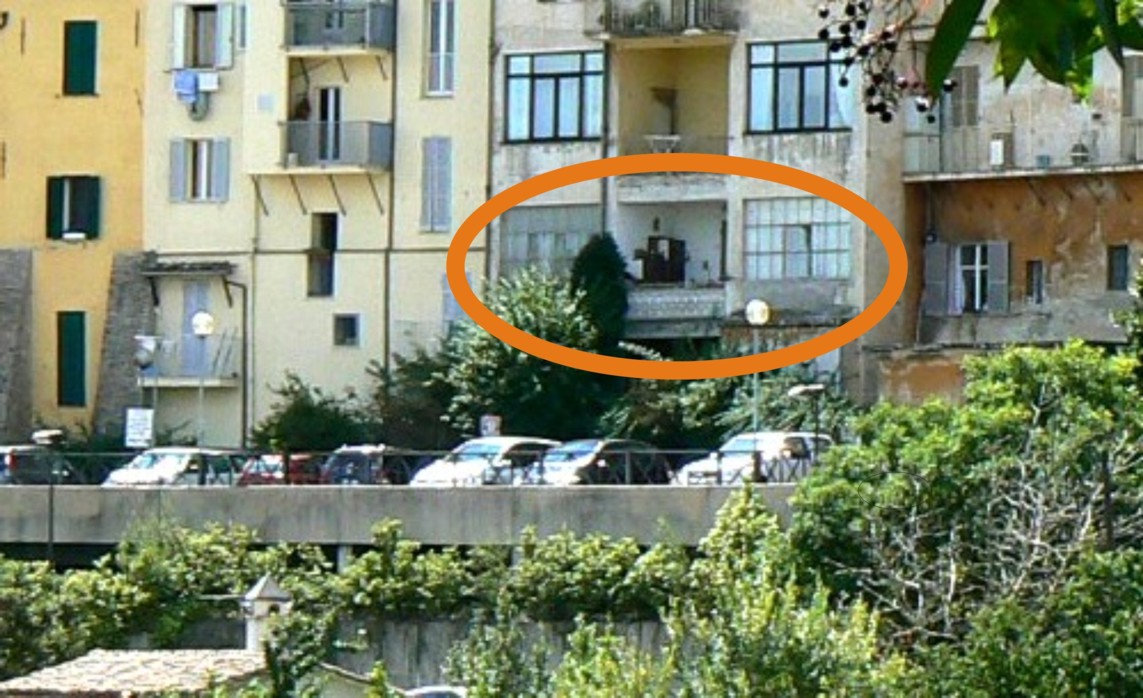
Here it is again in relation to the cottage

In the first picture Nara’s first floor flat is shown circled. In the second, it is obvious that only the roof of the cottage would be visible from the first floor, as indeed she said in her testimony.
There are two further floors above. The top floor is the one to which Ciolino (and Pater Van Sant) gained access, having tried but failed to interest Nara. Nara in her evidence said that there was an apartment above which she rented out and I suspect that this was the top floor. The top floor undoubtedly had double glazing or double casements.
Below is one of the top floor windows. (We can see Ciolino’s reflection in the glass)

And here he is, standing in front of the same window whilst conducting his experiment with a couple of kids running along the road outside -
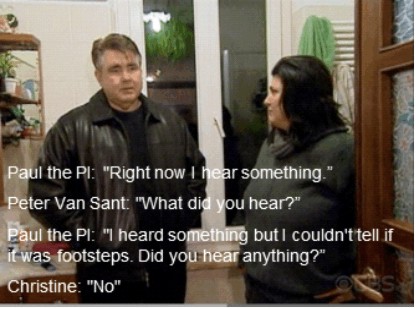
As we shall see it really was quite pointless conducting off-the-cuff sound experiments from there with the double casement shut tight
Nara said that her daughter also lived in the building so either the second floor was a separate conversion for her daughter or first and second were shared and the second was where their bedrooms were. That’s actually immaterial as it is the first floor that really interests us.
Here is a close up of the first floor. We can be sure because we can see Nara and the co-presenters of the Channel 5 documentary standing on the balcony.

We can see how large the windows are on either side of the balcony. As to the window on the right it is also apparent that this has been blocked up save as to four panes in the middle so that now there is only that smaller window there.
Let us now look at that window from the inside.
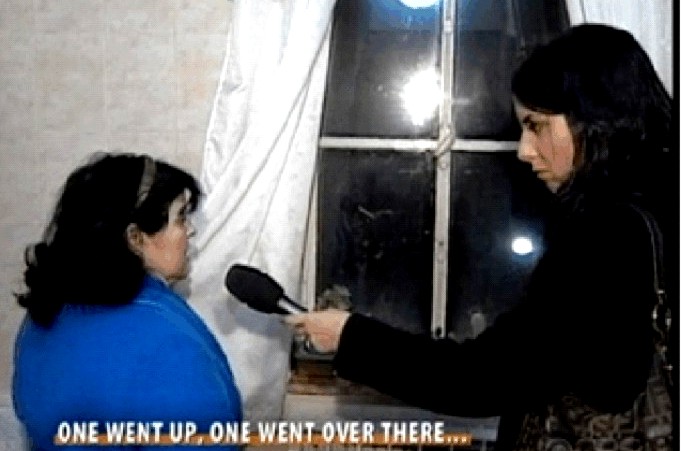
“One went up, one went over there” is Nara explaining to the Italian TV reporter the sounds she heard.
Clearly then she is standing inside her bathroom and the bathroom window looks over the car park. Indeed we can see her succulent plants on the inside window ledge as she stated in her evidence. Also, if we look closely, we can see that her wall is tiled or wall-papered with a tile design befitting a bathroom. Probably that wall is also made of little more than plasterboard.
One thing is quite certain though and that is that the window, which opens in the middle, is not double glazed.
Nara’s understanding however seems to be rather different. To her “double glazing” is (as she said to Dalla Vedova) “two panes in each side and opening in the middle”.
We can also infer that the large window to the left of the balcony belongs to her dining room. What she said, in effect, was that she was traversing the first floor (from left to right) from her dining room to her bathroom (being both on the same side, as she says). She heard the scream in her dining room.
The window there does not appear to be blocked off as it is to the right. Indeed I think we can see full length drapes or net curtains but certainly one would expect a larger window there and again, clearly, it is not double glazed.
So again, why would it be physically impossible for her to have heard a sound, particularly a scream, coming from the cottage?
It couldn’t be because it was too far away. We can see that from the pictures but also here is a handy GoogleMap calculation of the distance from her place to the far side of the cottage.

So that’s, say, 45 metres. Or 49 yards. Not far at all. Thanks to Yummi for bringing that up on pmf.org.
We should also remember that it was the 1st November which is a religious holiday in Italy in remembrance of the dead and therefore background noise was quieter than usual. It was also probably sometime around 11pm and the back of Nara’s property looks out on what is a natural amphitheatre in which noise will echo.
Nara Capezalli in fact came across as a compelling witness to what she heard that night and there is no way at all that it was physically impossible for her not to have heard that scream. Nor the metal stairs (”..makes a tremendous noise at night””¦.) just off to the right of her property and immediately below it.
On a personal note I was recently driven nuts by a manhole cover that had come loose in the road outside my bedroom window. Cars constantly drove over it and the noise kept me awake. The top floor of the car park would probably also act like a sounding board and the noise made by the stairs may also have come up through the stairwell we see immediately in front of her property. I am not so sure about the sound of gravel on the cottage forecourt being crunched underneath but already I am more than prepared to believe Nara on that score as well. Why not?
Finally, as we await the Cassation Motivation (whenever!) I seem to remember that at least one appeal point was the failure of the lower courts to accede to a defence request for audio tests to be conducted from Nara’s property.
Bearing in mind that Judge Marasca reportedly has stated that the ground for overturning the Nencini convictions was insufficient and contradictory evidence one wonders whether Cassation will say that a test was required, in the absence of which Nara’s testimony can be thrown into a pot along with other evidence somehow deemed “insufficient”?
If they do then watch out for them getting the double glazing issue quite wrong as well.
Sunday, July 05, 2015
Our Conclusions In “Deceit” & “Dark Matter” And How Our Journey Took Us To Them
Posted by Nick van der Leek
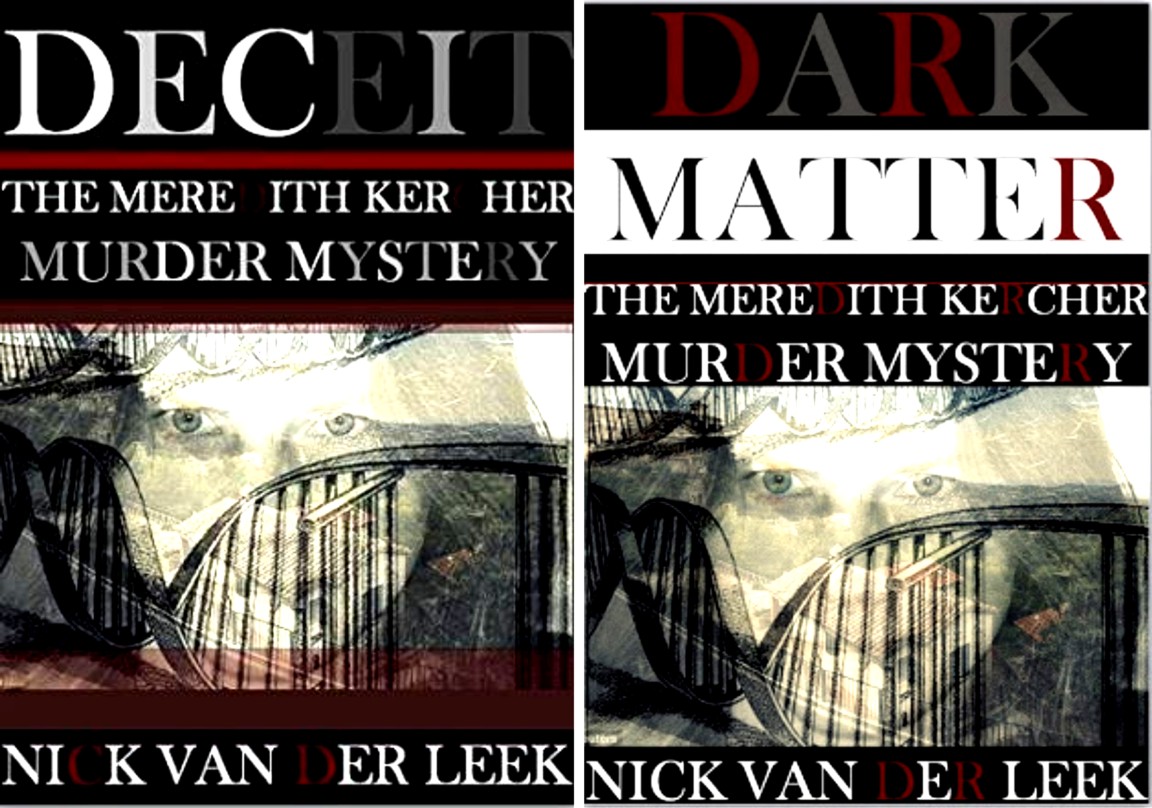
Albert Einstein once said, “It’s not that I’m so smart, it’s just that I stay with problems longer.”
One of the tremendously rewarding experiences we [my co-author Lisa Wilson and I] have as authors is our research forces us to set up camp around questions. We spend time: mornings, afternoons, days, weeks, even months asking questions and pursuing answers. The amazing thing when it comes to True Crime, especially popular crime, is those answers are out there. One merely needs to go out and make the effort to look for them. And keeping looking. Seek and we do find!
What makes our narratives distinctive, I think, is that Lisa Wilson and I more often than not work as a team. How many other narratives have two authors, working from opposite sides of the Atlantic? While Lisa provides a US perspective as a juror and a True Crime buff, I am more interested in the intuitive subtleties that underlie these cases. The psychology, the economics, the motives. Human behaviour is fascinating, especially when it drives people to the extreme. I’m also intrigued by what these intuitions reveals about us, and society.
I wasn’t always into True Crime, in fact like Ann Rule I sort of fell into it by accident. While Rule worked with Ted Bundy, I was facebook friends with the model Oscar Pistorius shot dead in his bathroom. I didn’t intend to write a novel, I simply started asking questions, and then penned a 12 000 word magazine article [intended as a 4 part series]. That narrative eventually became my first bestseller.
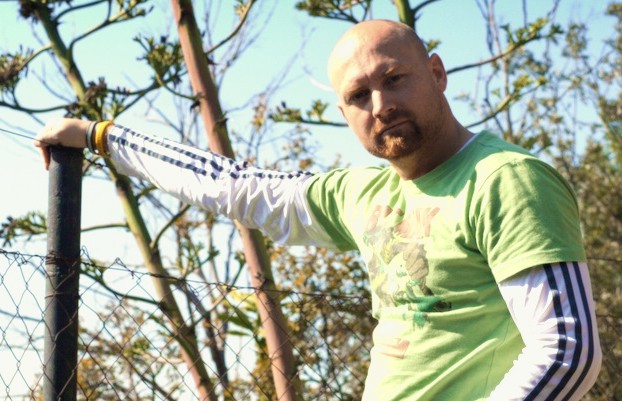
Although I studied law and economics, I left the corporate environment to freelance fulltime as a photographer and writer. My great grandfather was a famous South African artist, and my brother and aunt are also both well regarded artists [and yes, freelancers] in their own rights too. I guess there is something restless in my blood that makes we want to dig beneath the surface, to see expanded perspectives than what the media serves us.
I need to not only explore the world beyond my door, but represent it to myself and others in a constructive and meaningful way. I feel passionate about meaning above all, and it’s gratifying to find so much in so grim a setting where someone has lost their life. When we honour them, when we remember them honestly, something unexpected happens: we also set ourselves straight, we also get ourselves [and society to some extent] back on track.
In terms of the Amanda Knox case, I stepped into the bullring for the first time in April this year. I knew virtually nothing about the case other than it had been newsworthy around the world. I knew “˜something’ had happened in Italy, and that Amanda Knox was somehow involved [or not] because she was a housemate of a murdered British girl [also a student]. Before I started studying the case I had no bias either way ““ I didn’t know whether she was guilty or not. Based on the little media that came my way, there seemed to me to be equal parts bias that she was innocent and”¦suspicion.
As soon as I started examining the case, literally within a few minutes, my interest was aroused. It was along the lines of: she’s hiding something. It was also along the lines that I thought Amanda might be involved in some way, complicit in some way, but probably not involved in the actual murder. How could she? Why would she?
Again, it is easy to ask these questions and then walk away from them without investing time in their answers. And when they do come they’re”¦well”¦stupefying.

While Lisa travelled to Italy to investigate this case first-hand, I started working behind-the-scenes on a narrative Lisa and I designed a framework for called DOUBT. The plan was that Lisa would return and then we would work on the narrative together. I got so caught up in my own research I started on the narrative and by the time Lisa returned from Italy DOUBT was done. Interestingly, Lisa still wasn’t convinced of Amanda’s guilt when she got back, and we had one or two heated Skype calls while Lisa was still in Italy, where Lisa’s position was set to the default setting of most outsiders to the Amanda Knox case: “but there was no DNA.”
A lie repeated often enough eventually becomes if not the truth, then a kind of truism, doesn’t it? A truism isn’t the truth, it’s a platitude. It’s something you say to get rid of enquiring minds.
No DNA? Well, of course there is ““ at least five instances of it, mixed with Meredith’s blood. What’s perhaps more bizarre, for example, is the lack of Amanda’s fingerprints in her own home. A single print? How many of us could say the same about fingerprints in our own homes? Our computers, door handles, kitchen areas ought to be splattered with prints. Coming back to DNA, not only is Amanda’s DNA present, but so is Raffaele’s in Meredith’s bloody bedroom.
What is the chance that Raffaele was at the villa, in Meredith’s room, but not Amanda? What was he doing there if Amanda wasn’t with him? And is it any surprise that Meredith’s bra, cut with a knife after the murder also had Raffaele’s DNA on the bra clasp? This is a guy who had a knife fetish, and who was carrying a knife at the time of his arrest?
In DOUBT [which was banned at first by strident Pro Knoxers and then resurrected as DECEIT] I identified 28 Red Flags. These were singular signals that seem to show patterns of inconsistency. Things just didn’t add up. Indeed Amanda did seem to be [and still is?] hiding something. In DARK MATTER Lisa and I joined forces. We brought a binocular lazer-like narrative focus to the four days of intense police investigation following the discovery of Kercher’s body at midday November 2nd, 2007.
In DARK MATTER we identified an additional 100 plus Red Flags [we distinguished these from the first 28 by calling them “˜Black Asterisks’]. In addition to these we listed several other Highly Suspicious Events amongst other increasingly odd behaviours ““ not only from Amanda, but Raffaele as well. It is when we pool all of these clues together that a picture begins to emerge. Patterns emerge. And suddenly the mystery becomes”¦less mysterious.
If my initial “˜gut feel’ was that Amanda was simply “˜hiding something’, by the end of DECEIT there was little doubt that there was a lot more going on than that. In fact, I’ve suggested to Lisa that based on forensic evidence alone [if one threw away all the circumstantial evidence], Amanda would still a have a major case to answer to. Conversely, if one took the entirety of circumstantial evidence, including the on-again-off-again alibi, and simultaneously threw out [ie ignored] the totality of forensic evidence, Amanda would still have a major case to answer to. That’s my opinion. Lisa’s too, now that she’s gone beneath the surface of this case herself.
The irony is this case is so large, so convoluted, so filled with spin and counterspin, that it is easy to get lost in the details. As we see so often in court cases, it is not a lack of evidence that is a problem, it is the volume of it that gets disconcerting, and frequently confusing. Confusion and doubt [and “˜reasonable doubt’] go hand in hand. Of course being confused by a lot of information is not the same as uncertainty based on a lack of evidence, or based on ambiguous evidence. The evidence isn’t ambiguous.
As such it is Lisa’s and my mission to demystify the eight years culminating in Amanda’s and Raffaele’s ultimate acquittal. Our narratives, especially the first two or three in the series are probably better suited to newbies [people like us]. In THE IVORIAN, and the many narratives to come after that, Lisa and I expect to be as well versed as some folks on forums and resources like the incredibly valuable True Justice.org.
Before wrapping up, I’d like to share a final insight based on our experience writing another true crime series. It may seem like Amanda Knox, Jodi Arias and Oscar Pistorius are three distinct individuals, with nothing in common. But when we look closer we don’t simply see matches in certain defense schemes, we see entire patterns of conduct [including motive] overlapping, and doing so perfectly.
In South Africa we have a similar situation where the media profit out of stories on Oscar Pistorius. They are reluctant to declare him guilty as that would be slaying a potential “˜cash cow’, and with book deals hanging in the balance [an acquittal is literally worth millions], the media are hedging their bets.
As a person involved in the media I am appalled at this, hence our eight narratives on Oscar, two detailing his motive and the method of what we speculate was premeditated murder. In terms of Amanda Knox, we suspect a similar game play between the media and Knox. Both seem to be involved in a kind of PR waltz which both stand to benefit from, if they can dance consistently to their own music.
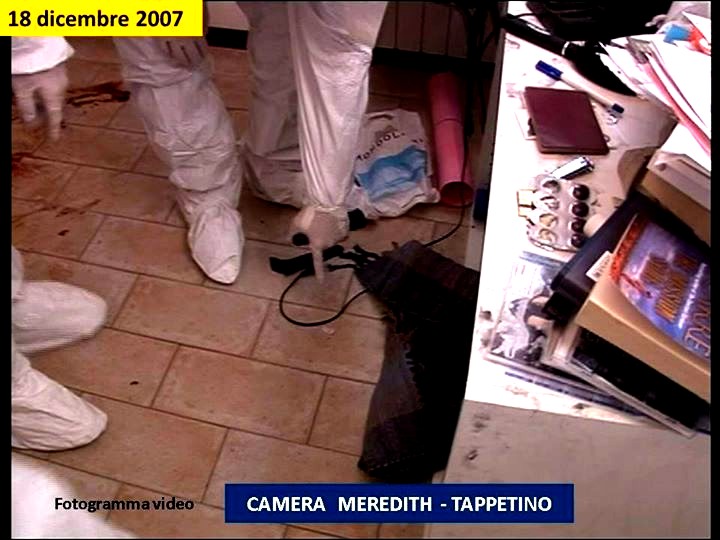
It was once said of Lance Armstrong that one shouldn’t make Lance Armstrong angry. Anger is what motivates Lance to win. And then the punch line: “˜Beating Lance makes him angry.’ Lisa and I have been astonished at the level of organisation and aggressive militancy [and dirty tricks] employed by Amanda’s supporters. If this was intended to dissuade us from writing, these folks couldn’t be more wrong.
We are not out to make money, Lisa and I, although we care that our narratives resonate and are successful. What we really care about is justice. The bottom line, whether one is a criminal, or the supporter of a criminal is you never look good trying to make someone else look bad. The venom and personal insults Lisa and I have endured in our reviews is impressive. The strategy is clear ““ attack the credibility of the messenger [since the message itself is problematic].
Our credibility is simple to establish. For my part, I am a professional writer. I did not gain a twitter following of almost 14 000 based on bad writing. I write in partnership with Lisa because her research is often deeper and even more thorough than mine. For me our credibility is based on just two tests: our personal standards and our level of honesty towards ourselves and others. What distinguishes our narratives from all the others out there is the level of honesty ““ including self disclosure ““ both of us bring to our work.
This is because we care about something beyond justice. Besides wanting our readers to have a meaningful and genuine experience reading about these tragic crimes, we ““ as authors ““ also want to be enriched. When we make it a personal journey, the insights and intuitions are truly rewarding. We find how these folks ““ not only the victim but also the perpetrators ““ are not so very different from us. In this sense, if when we genuinely learn something from these true stories, Meredith Kercher’s death need not be in vain.
Follow Nick van der Leek on twitter @HiRezLife and Lisa Wilson at @lisawJ13
Please “like’ Nick van der Leek’s Facebook page.
Tuesday, June 09, 2015
Why Desperation Sets In At The Pesky Similarities Between Amanda Knox And Jodi Arias
Posted by Chimera
1. The Incessant Comparisons
Google “Amanda Knox” along with “Jodi Arias” who was recently convicted of killing her ex-boyfriend and you will see what I mean.
Of comparisons between the two, there are many dozens. Some pieces damningly list the similarities, and then in numerous defensive comments the facts about the real Knox get mangled. Some pieces try to argue that there are differences, and in comments the writer’s numerous false claims get nailed.
To bring out quite forcefully the stark similarities, this post looks at the interrogations. At the time of this posting, Arias has been convicted of first degree murder, but sentenced to life without parole, since the jury would not hand down the death penalty.
Meanwhile, Knox has been provisionally found not guilty in a highly suspect Fifth Chambers action which might be overturned by an order of the President, or by a challenge by the Florence court, or by a challenge by another arm of the Supreme Court.
2. Similarities Under Interrogation
Below is all of Arias’s 2008 interrogation after her arrest (posted in 4 parts) with notes on some of the similarities. Knox was only ever interrogated once, on 17 December 2007 (at her own request), in a couple of hours, so I also draw on some of her other statements.
Most of what Jodi Arias says is just babbling and rambling, a trait common to Knox. But unlike Knox, Arias doesn’t have a media campaign going on to release her, and Arias hasn’t been able to bend or corrupt any courts.
Part 1 (2 hours 40 minutes)
Part 2 (2 hours)
Part 3 (2 hours)
Part 4 (2 hours)
Assessment
My view from watching this: Arias is truly emotionally vulnerable here, but even so, her mind is constantly trying to get her out of this.
The problem is that she doesn’t seem to register just how much the contradictions ensnare her. Arias, like Knox, thinks she can talks her way out of anything. She seems stunned that her ‘‘little-girl routine’’ doesn’t win over the police.
Arias seems to think during the police questionings, she can simply make it all go away if she keeps denying. Problem is, her interview is riddled with partial admissions. Knox seems to think that she can win over the media if she keeps denying ‘‘she killed her friend’‘.
However, when Arias finally does testify, she is cold, sarcastic, and testy. (Sound familiar?)
I imagine if Amanda Knox ‘‘had’’ been formally questioned without lawyers, it would have looked something like this. Yes, it is segmented, but it would be mindnumbing to do a complete transcript. However, there were many gems from this questioning. It is chilling to watch, but if you can, do it, and ask yourself if that isn’t another ‘‘Knox’’ performing there.
Note these telling exchanges, all from Part 1
(5:46) Det. Flores: I travelled all the way up here to talk to you. Because, I’ve been working on Travis’ case ever since it happened. And I know exactly what happened, how he was killed. I know a lot of details. And just recently we found quite a bit of evidence, and I’ll discuss that with you. The main thing that I’m looking for though is answers, on why certain things happened, and also to get your statement.
(6:25) Arias: Okay.
(6:35) Det Flores: A lot of details in this case haven’t been released to the public or even to Travis’ family yet. And those details are known only to us, and to the person who did it. And that’s why we’re here. I believe you know some of those details, and you can help us.
(6:51) Arias: I would love to help you in any way that I can
One of the most laughable statements ever made in the case. 8 hours later, she still won’t give them a straight answer.
(8:45) Arias: Should we record this? (reaching for the remote).
Seriously? Arias has been arrested for murder, and her first act is pretend to be ‘‘helping the police’‘. A bit like Knox, who insisted she was helping the police, even after being charged with Meredith’s murder
(10:35) Arias: I know that people have been posting a lot of really nice things on Facebook, you know, memories, and I thought maybe I should do that. And I realized looking back in it is sounded immature, more like a ‘‘Dear Travis’’ kind of letter, so I took it down…
(10:53) Det Flores: Personal?
(10:55) Arias: Yeah, some of it was personal, not too personal, nothing inappropriate.
At least least Arias isn’t emailing people questions about whether Travis likes anal, or what he uses vasoline for. Give her some credit.
(12:00) Arias: I didn’t realize until I was speaking with Ryan Burns, the guy that’s in Utah. We’ve been talking, we try not to talk about that, because it’s kinda like ... ugh (makes disgusted face). And plus Travis is my ex-boyfriend, so, when you’re mourning your friend, how do you talk to to your new potential mating person? .... So, it’s kind of a grey area.
Yes, Jodi thinks dead bodies are ‘‘yucky’‘, and that mourning an ex, while talking to a new potential partner is a ‘‘grey area’‘. Did she go run off to buy any lingerie?
(12:15) Arias: I try not to talk about it too much, but he [Travis] comes up a lot
Your ex-boyfriend was stabbed 29 times and shot in the head. Annoying, how often ‘‘he’’ comes up.
(12:20) Arias: And it was though him [Ryan] that he thought things were really weird, and some think that you had a hand in it.
Maybe because you find the topic of your ex so annoying when you try to spend time with new boyfriend….
(12:28) Det. Flores: I’ve talked to a lot of people. And everyone is pointing the finger at you.
(12:35) Arias: I know.
(12:36) Det Flores: Everyone is saying - I don’t understand what happened to Travis. I don’t know who killed him, but you need to look at Jodi. And sometimes the simplest answers are the correct ones.
Something Knox found out (and soon Arias soon will), is that when you have suspicions about someone, you bring them up immediately. You don’t wait until you become a supect yourself.
(13:30) Det. Flores: I know that you still had a relationship of convenience, even though you were not boyfriend/girlfriend anymore, that you two were still having sexual relations with ...
(13:45) Arias: Does his family know? Just curious.
(13:50) Det. Flores: No, his family doesn’t know anything.
(13:54) Arias: I’m interested in protecting how he is remembered as well.
Another laughable claim. Jodi would later accuse him of everything from being abusive and controlling to pedophilia. Knox uses Meredith’s memory to cash in on a blood money book ‘‘Waiting to be Heard’‘, does dozens of interviews claiming to be a victim, and uses her website to raise money for her legal fees to get off on Meredith’s murder.
(16:10) Arias: Too much of my nightlife was about him [Travis]. He would text ‘‘hey I’m getting sleepy….. zzzz’‘. That was his code for ‘‘coast is clear, come on over’‘. (long, unrelated rambling).
Less than 3 minutes after saying she wants to protect how Travis is remembered, Jodi is already implying Travis is horny, and leaking unnecessary details. An attempt to smear him? Who else does that?
(19:20) Arias: I used to always joke, ‘‘that, regardless of what the Bible says, and yes I’m Christian, I just live my life by the 10 commandments, and that those are my rules,
‘’ .... so I always used to joke about that.
Your ‘‘friend’’ has been savagely stabbed to death, and after being arrested you are making jokes about fornication. Who else would make such jokes after the loss of a close one?
For the next 15 minutes Arias babbles on about unrelated things. Det. Flores has incredible patience, as most would have slit their wrists listening to her. But finally he tries to pull Jodi back to the topic at hand.
He makes several attempts, but Arias keeps trying to divert the topic away from Travis and his death. After about 1/2 hour of Jodi talking nonsense, Detective Flores tries to get Jodi to give a timeline and direction of her travels.
(52:20) Det. Flores: So, you took this trip and you left on Monday the 2nd until Thursday?
(52:44) Arias: I think so.
(52:50) Det. Flores: So, we have here about 48 hours…. this trip would take you a little over 48 hours…. I have a problem with this trip.
(53:06) Arias: Well I first went to ....
(53:30) Det. Flores: I’ve gone over this trip over and over in my mind. There’s still 20-some odd hours, even if you pull over to sleep, a couple of times ....
(53:42) Arias: Did I tell you I got stranded?
(53:46) Det. Flores: Yeah, you mentioned that. If you slept for 10 hours, here and here (pointing on map), it would still leave 18 some odd hours, for something else. This is the trip that people are focusing on. People are saying that she left .... Travis was killed on Wednesday.
(54:22) Arias: I did not go near his house.
(54:27) Det Flores: I pulled your cell records. Your cell phone was turned off, between here and here (indicates on map). What does that show me?
(54:45) Arias: No, no, no.
(54:50) Det. Flores: Is there plenty of time for you to do this? Yes. And do I believe that you had come to visit Travis? Yes. Did you have the opportunity? Yes, there were no other witnesses.
(55:10) Arias: Well, I didn’t turn it off physically, but it died.
(55:16) Det. Flores: And you magically found your charger here? (pointing on map)
(55:20) Arias: It was under the passenger side of the front seat.
(55:23) Det. Flores: When you were lost, you couldn’t have pulled over and found it?
(55:41) Det. Flores: I’ve been focusing on why your phone turns off here, outside of Los Angeles ... because the [Highway] 15 goes through Las Vegas. It never goes through Arizona.
Detective Flores zeroed in on a huge gap Arias’ timeline. Why did a 48 hour trip take more than 3 days? He also noted that her cell phone was not active for most of that trip.
In Peugia, the police had noted a discrepancy in Sollecito’s timeline. He claimed to have reported the burglarly then waited outside for the police. In fact phone records showed the Postal Police showed up about 15-20 minutes before he made the call. It was later discovered that Knox and Sollecito had turned off their cell phones (something they never did), during the time of the murder.
(58:25) Det. Flores: Were you at Travis’ house on Wednesday?
(58:28) Arias: Absolutely not. I was nowhere near Mesa.
She is very sure then, but with some more questioning, she will not only be there, but a witness to the actual murder.
(58:40) Det. Flores: What if I could show you proof you were? Would that change your mind?
(58:45) Arias: I was not there. (trying to look convincing)
(58:59) Det. Flores: You were at Travis’ house. You had a sexual encounter. Which, there’s pictures. And I know you know there’s pictures, because I have them. I will show them to you. So, I am asking you to be honest with me. I know you were there.
(59:30) Arias: Are you sure that those pictures aren’t from another time?
(59:35) Det. Flores: Absolutely positive.
(59:40) Arias: The last time I had any sexual contact with Travis was in May.
(59:55) Det Flores: You know how I told you about the camera? The camera was damaged. Someone put it in the washing machine, ran it through a wash cycle, with some clothes of Travis’, but the card is intact. You know how I told you the card was destroyed? I didn’t want to tell you the truth, because I wanted to make sure the photos were accurate. We can pull deleted photos, even from 6 months ago. And I have pictures of you and Travis.
(1:01:00) Arias: Are you sure it was me? Because I was not there.
(1:01:00) Det. Flores: Jodi, it’s you.
Arias is trying to look and sound convincing, but her denials come out weaker and weaker. But the stunned look shows through.
(1:01:55) Arias: I didn’t hurt Travis. He’s done so much for me.
But like your Seattle ‘‘colleague’’ you will soon trash the memory of the person you called a friend.
(1:02:00) Arias: I lived there. I lived there for months and months.
Pretty much the excuse Knox used to explain her DNA being everywhere.
(1:02:15) Det. Flores: I know you took pictures in the shower just before he died.
(1:02:29) Arias: I don’t think he would allow that
Either you did, or you didn’t.
(1:05:30) Det. Flores: our record indicate you reported a gun stolen, a .25 auto, which just happens to be the same caliber used to kill Travis.
(1:06:10) Arias: A .25 auto was used to kill Travis?
Using a ‘‘drop piece’‘, reported stolen, brought to the murder scene. Knox brought one of Raffaele’s knives.
(1:06:18) Det. Flores: Do you want to see pictures of him?
(1:06:25) Arias: Part of me does, part of me doesn’t.
(1:06:30) Det. Flores: Why, because you don’t want to remember?
(1:06:35) Arias: No, there’s a morbid curiosity.
Arias is curious to see photos of Travis. In fact, she asks several times to see photos of him (after the fact). The detectives wonder if it is to help her come up with a story, but it is possible she just wanted to see her handiwork
Knox had also made several public demands to visit Meredith’s grave. Creepy as hell.
(1:06:50) Det. Flores: I can’t deny this evidence. The trip you took doesn’t make any sense, the opportunity was there, the pictures on that date with him, your blood is in the house - mixed with his, not alongside, but mixed, your hair is there is blood, and your palm print is there, in blood. Your image is not important, saving the rest of your life is.
(1:07:30) Arias: Listen, if I’m found guilty, I won’t have a life. I’m not guilty.
To compare Det. Flores’ listings: Knox’s account of the night/morning made no sense; she had access and opportunity; she had 5 spots of mixed DNA with Meredith, and oddly, NO fingerprints were found in Knox’s own home.
Jodi’s denial is extremely weak, just like many of the ‘‘no evidence’’ denials that Knox makes.
(1:08:20) Arias: I’m not a murderer, but if I were to do something like that I’d wear gloves, or something.
Wow…. way to be convincing.
(1:09:35) Arias: Let’s say for a second that I did. Suppose I say I did. Why
(1:09:50) Det. Flores: The motive is there. Anger, jealousy ....
Knox frequently argued along the lines of ‘‘there is no motive for me to do this’‘.
(1:29:30) Arias: If I was ever going to try to kill someone, I would use gloves. I’ve got plenty of them.
This is the second time Jodi mentions this. Like Amanda, she knows a little something about C.S.I.
(1:29:55) Det. Flores: Would they see your car, or did you park it down the street?
(1:30:05) Arias: No, they would see it, I drove an Infinite.
(1:31:42) Det. Flores: You know that all rental cars have GPS on them? For us to use….
Oh, s**t.
(1:42:15) Arias: Is it possible that my memory card was in his camera, and they are interchangeable?
(1:43:30) Det Flores: You’re saying that someone took your pictures and your memory card and was framing you?
Knox has written before that she thinks Raffaele planted her fingerprints on the knife used to kill Meredith. Everything is a conspiracy.
(2:01:00) Arias: I’m trying to put his death behind me.
So…. you just want to get on with your life?
3. Numerous Other Similarities
- Arias had cuts on her fingers which she said was from ‘‘dropping glass’‘. She claimed that happens regularly. Police believed it was from the knife slipping in her hand.
- Knox had a cut on her neck which she said was from a ‘‘hickey’‘.
- Arias claimed her phone died while on the road and that she found her charger later
- Knox claimed she turned her phone off so she would not receive a text in case Patrick wanted her to come in afterall. She previously claimed that it was to preserve the charge for her Gubbio trip
- Arias was asked if anyone else was present at the scene. She invented a story about 2 masked intruders.
- Knox was told Sollecito removed her alibi. She invented a story about Lumumba doing the crime.
- Arias has given prison interviews and basked in the limelight
- Knox has given interviews since being released from prison and basked in the limelight.
- Arias refused her own suggestion for a lie detector test since if it wouldn’t help her in court,
- Knox says she will take a lie detector test, but never has.
- Arias attempted to destroy evidence, including attempting to destroy a camera in the washing machine.
- Knox attempted to selectively clean the crime scene, and pin it all on Rudy Guede
- Arias had the foresight to clean her feet before, going to the washing machine to throw the camera in.
- Knox (or Sollecito), had the foresight to clean his/her feet before going into Amanda’s room to grab the lamp.
- Arias had the foresight to clean her hands before grabbing Clorex to put in the washing machine
- Knox had the foresight to leave Meredith’s lamp, but use her own and wipe it for prints
- Arias put her licence back on upside down (it was removed while at Travis’ house).
- Knox put the bathmat (with Sollecito’s footprint), back upside down
- Arias staged a prior break-in so she could report a gun stolen, which she would later use.
- Knox staged a prior break in and later used some techniques on Meredith.
- Arias planned it by using a ‘‘trip to Utah’’ as a way of explaining her time away.
- Knox planned it by waiting for a time when no one else was home.
- Arias tried to wash Travis’ body to destroy evidence.attempted to destroy evidence.
- Knox (and Sollecito), stripped Meredith down to make it look like a rape.
- Arias called Travis’ phone and left voicemails to make it look like she didn’t know he was dead.
- Knox called Meredith’s phone to make it look like she was trying to reach her.
- Arias had sex with Travis prior to killing him
- Knox had sex with a drug dealer (Federico Martini), before and after killing Meredith.
- Arias caused Travis to think she was dangerous and a stalker, leading to police suspicion after.
- Knox caused Meredith and others to think she was pushy and weird, leading to police suspicion after .
- Arias rented a car, bought cans of gas (to avoid stopping at gas stations), reported her gun stolen (so suspicion wouldn’t be aroused), and turned off her phone.
- Knox brought a knife from Raffaele’s flat, brought 2 ‘‘frame-able’’ accomplices, chose a night no one was home, and turned off her phone.
- Arias attempted to rain hostility down on prosecutor Juan Martinez.
- Knox attempted to rain hostility down on prosecutor Guiliano Mignini.
- Arias flirted with the police who arrested her.
- Knox flirted with court officers.
- Arias went to her current boyfriend as if nothing happened.
- Knox went back to her life, including missing Meredith’s memorial.
- Arias murdered her ex-boyfriend.
- Knox murdered her roommate.
- Arias called Travis repeatedly just to hear his voicemail. Stalker?
- Knox texted Meredith repeatedly the day before. Stalker?
- Arias was born July 9, 1980.
- Knox was born July 9, 1987.

